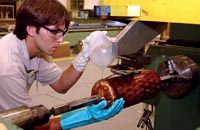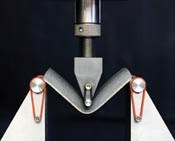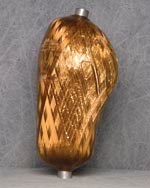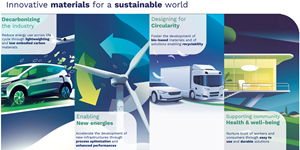An update on composite tanks for cryogens
More automation, improved materials bring composite fuel tanks for space applications closer to reality.
In space vehicles, size may not matter, but weight does. Hoisting a payload straight up to escape Earth's gravity requires a phenomenal expenditure of energy, and every ounce saved in either launch vehicle or payload weight translates to lower project costs. Lightweight and strong composite materials are already deployed in many applications, such as launch vehicle bodies, fairings and payload components. But tankage for super-cold liquid fuels — liquid hydrogen, liquid oxygen (LOX) and others — is still the purview of metals.
Why? Despite years of testing, concerns still exist about the potential for leaks, due to microcracking of traditional carbon/epoxy composite laminates at cryogenic temperatures. Microcracks can occur in any laminate because of the difference between the axial and transverse coefficients of thermal expansion (CTE) in each ply, explains Brian Wilson, president of Wilson Composite Technologies (Folsom, Calif.). "Transverse microcracks in the resin can be generated between the fibers as the laminate cools after cure, and as temperature is lowered to cryogenic levels." Even at moderate pressure, the composite's exposure to temperature extremes and repeated fill-and-drain cycles causes thermomechanical loading, which exacerbates cracking and leads to permeation leak paths, easily traversed by small hydrogen and oxygen molecules. The issue isn't helped by the fact that most thermoset systems lose strain capacity and become brittle at cryogenic temperatures.
Designing for containment of LOX poses particularly difficult problems. Any permeation leak poses a potent ignition-and-explosion hazard. There is unresolved debate in the industry as to whether LOX, an aggressive oxidizer, actually reacts with and degrades composite materials — some, including Wilson, say that a cured composite is not affected. Composites also have a tendency to pop, flash or char if impacted mechanically while in contact with LOX, because the mechanical energy of the blow causes a rise in heat within the material, which can, in turn, cause autoignition.
Tom DeLay, a researcher in the area of nonmetallic materials and processes at NASA's Marshall Space Center (Huntsville, Ala.), notes that the many composite cryogenic tank development programs initiated over the years have certainly resulted in technology improvements, yet most had budgetary and schedule constraints that did not permit researchers to identify or qualify the optimum materials for cryogenic environments. "The industry wanted a composite to do everything: handle cryogenic fluids, minimize microcracking, handle launch loads, have a high glass transition temperature, and be chemically compatible with the fluid," DeLay says. "This essentially makes the composite an aluminum substitute."
Despite setbacks and upheaval within NASA, including the loss of a Space Shuttle, several groups are continuing to investigate composite cryogenic fuel tanks. Some say new developments may be on the way, including new, optimized materials and smaller yet higher-pressure tanks for space propulsion systems.
Processing breakthroughs for large tanks
Lockheed Martin Space Systems - Michoud Operations (New Orleans, La.) has worked for more than 20 years on various NASA programs to adapt composites for cryogenic applications (see the Michoud profile in HPC January 2004, p. 30). [Editor's note: Hurricane Katrina closed Lockheed Martin's Michoud facility; limited production resumed on Oct.1.] The focus of the company's work has been on reusable, relatively low pressure, pump-fed or gravity-fed tanks of large dimensions — diameters of 1.8-3 meters and lengths of 9-18 meters or more — for launch vehicles. Lower weight has been the principal driver. Savings of 20-40% are possible, when compared to aluminum or other metals.
One of Michoud's many products was an unlined composite LOX tank for the proposed X-34 reusable, air-launched Shuttle-type vehicle, which was cancelled in 2001. The X-34 tank successfully passed a battery of performance-based tests for impact and multiple fill/drain and pressurization/depressurization cycles, a key tank performance requirement since tanks are often filled and drained on the launch pad if a launch is delayed or scrubbed.
Lockheed Martin has access to a state-of-the-art automated fiber placement (AFP) machine from Ingersoll Machine Tools Inc. (Rockford, Ill.), thanks to its membership in the National Center for Advanced Manufacturing (NCAM), which is located at the Michoud facility. Engineers have developed a new fiber placement technique, termed "in situ fiber placement" or ISFP, which they claim can produce net-thickness laminates, without the need for vacuum bag debulking or autoclave cure.
The ISFP process uses fully impregnated slit prepreg tape or towpreg that has been optimized during manufacture to eliminate entrapped air and resulting bulk caused by incomplete resin impregnation. With these materials, the ISFP process achieves full consolidation between plies using heat and compaction supplied by the fiber placement machine head. Material is debulked on the fly by heating it with hot nitrogen gas just prior to running it under a conformable compaction roller. The process has been demonstrated using various carbon/resin material systems, such as IM7/8552 epoxy, IM7/F650 bismaleimide (BMI) and IM7/5250-4 BMI, supplied by Hexcel (Dublin, Calif.).
Advantages include decreased processing time because lengthy debulking cycles are eliminated. Thick, curved structures with tight radii can be produced without generating wrinkles during cure. And because the laminate has already been consolidated during layup, vacuum bag/oven cure is sufficient, effectively eliminating the autoclave. This allows fabrication of larger structures with lower cost tooling materials.
Northrop Grumman Corp. (Los Angeles, Calif.) also has invested resources to develop out-of-autoclave manufacturing methods for large-scale, low-pressure cryogenic tanks, using tweaked off-the-shelf materials. Under the auspices of NASA's Next Generation Launch Technology program, which ended in mid-2004, the company produced two subscale demonstrators — reusable liquid hydrogen fuel tanks that have been produced with an innovative method involving ultrasonic energy.
According to Northrop Grumman's composite tank project leader Tod Palm, the fabrication method differs from the conventional in several ways: an inner tank skin is first layed up with very thin, unidirectional prepreg tape — at 2.5 mils, it's half the thickness of standard tape. This allows the laminate to be built up with many more plies. The result is a denser tank wall of essentially the same thickness, which helps limits hydrogen molecule migration through the structure. Laminate consolidation is accomplished with a new debulking method known as ultrasonic tape lamination (UTL), initially developed by Waltham, Mass.-based Foster-Miller Inc.'s Composites Technology Division (see HPC March 2004, p. 11). It works by directing ultrasonic sound waves onto the ply through a metal horn mounted on an automated gantry, close to the head. The resulting ultrahigh-frequency vibration encourages evacuation of trapped air, yielding good laminate uniformity and, according to Palm, "properties equivalent to autoclave cure."
To further limit porosity, Northrop Grumman researchers developed a permeation barrier film, consisting of a thin aluminum foil layer with epoxy film adhesive on both sides. The film is placed over the consolidated inner skin followed by a layer of aramid honeycomb core.
The honeycomb also is different: each cell wall is perforated with laser-cut holes. The idea, says Palm, is that any trapped air in the core cells could be evacuated with a small vacuum pump, either on the launch pad or in space, to prevent any leaking hydrogen from accumulating within the core cells and causing a tank skin disbond.
Like Lockheed Martin's concept, Northrop Grumman's on-the-fly ultrasonic consolidation method eliminates the need for vacuum bag and autoclave debulking steps. According to the company, tanks can be oven-cured at ambient pressure, and tank size is limited only by the size of the tape laying machine.
To date, however, only subscale articles have been produced by either company -- the future of large, reusable composite fuel tanks for launch vehicles is certainly not clear at this point.
Traditional winding with new materials
In contrast to the efforts described above, which have used commercially available (albeit somewhat modified) materials, Wilson Composites has worked for more than 12 years under contracts for the U.S. Air Force on some new material approaches. The company has developed composite tankage for Air Force space programs, e.g., the FALCON (Force Application and Launch from the Continental U.S.) launch vehicle. Wilson's philosophy is that carbon/epoxy cryogenic tanks can function successfully without liners or even conventional metallic bosses and fittings. "For composites to make sense as a lightweight metal replacement, you have to get the weight out," says Wilson. "The metal bosses at the dome ends represent 90% of the tank's total weight."
To make linerless tanks, the company has worked with a variety of carbon fibers in combination with toughened epoxies and cyanate esters supplied by Advanced Composites Group (ACG, Tulsa, Okla.), Bryte Technologies Inc. (Morgan Hill, Calif.), YLA Advanced Composite Materials (Benicia, Calif.), and A.T.A.R.D. (Lincoln, Neb.), among others. According to Wilson, the company has developed a microcrack-resistant fiber/resin system (pat. pend.) for towpreg (prepregged carbon tow) that is superior for cryogenic applications, based on the company's coupon test results. Wilson prefers towpreg to wet winding, claiming more consistent resin content for improved overall tank structure.
Several demonstration linerless tanks — as large as 1.8 meters long and 1.2 meters in diameter — have been filament wound and tested. Wall thickness is typically 2-2.6 millimeters for tanks containing fuels at 6.9-10.3 bar, says Wilson. One of the demonstration tanks was recently on display at the 2005 SAMPE conference and exhibition in Long Beach, Calif.
To replace metal end bosses, the company has fabricated composite bosses via resin transfer molding (RTM), and now is testing them. The same resin used in the towpreg is modified to a lower viscosity, to enable flow through the closed RTM molds. More tests of an all-composite tank are on the horizon, says Wilson, including a "flowing oxygen" test to measure whether flowing LOX oxidizes and erodes a tank's interior and its associated fittings.
Upstart rocket engine design firm XCOR Aerospace (Mojave, Calif.), the developer of the EZ-Rocket and other unique rocket-powered planes, has taken a very different approach to cryogenic materials. The company recently signed a $7 million (USD) contract for development of a demonstration composite LOX tank, under NASA's Exploration Systems Research and Technology program. According to XCOR's chief engineer Dan DeLong, the materials and the filament winding process under development could work for pump-fed low-pressure and high-pressure tank systems of any size. Initial applications will be for LOX storage in small rocket propulsion systems.
The company's material system is Teflon thermoplastic fluorocarbon resin supplied by DuPont (Wilmington, Del.), teamed with S-2 Glass from AGY (Aiken, S.C.). Various grades of fluorocarbon are currently being assessed. According to DeLong, the system is highly resistant to combustion in an oxygen environment and will not microcrack, because of its low CTE and high strain capability. "The fluorocarbon resin still has 20% strain-to-failure at cryogenic temperature," he says, citing the greater flexibility exhibited by thermoplastics at low temperature.
Tank design includes three components:
- An inner skin of the Teflon/S-2 material to handle contact with the LOX
- A core of high-performance Rohacell PMI foam (supplied by Rohm GmbH & Co., Darmstadt, Germany) for both insulation and structural strength
- An outer aeroshell of carbon/epoxy to take the aerodynamic and vibration loads.
Even with a thermoplastic matrix, the outer carbon/epoxy aeroshell gives the tank enough strength to act as part of a space vehicle's structure and bear significant loads, says DeLong. No separate metallic or thermoplastic liner is required.
XCOR will filament wind over a removable mandrel to make a demonstration tank article large enough to contain 900 kilograms of LOX (a capacity of about 1 cubic meter). The company uses a proprietary process to convert the fluorocarbon/S-2 into towpreg. Approximately three plies will make up the inner skin for a low-pressure tank — more would be added for higher pressure applications. Core thickness ranges from 6 millimeters to several inches, depending on thermal insulation requirements. The aeroshell is designed and wound to fit the particular application as needed, says DeLong. Ancillary parts, such as baffles, sensor mounts and access panels, also could be made with fluorocarbon/S-2, using hand layup of prepreg and a thermoplastic heat-sealing process.
So far, numerous successful coupon-scale tests have been conducted with liquid nitrogen at -195°C (a slightly lower temperature than LOX at -183°C), including measurement of CTE, tensile strength (at both ambient and cryogenic temperature), and porosity and microcracking, with and without temperature cycling. DeLong foresees applications for XCOR tanks like methane fuel tanks for rockets, larger rocket propulsion systems or, eventually, even fuel storage on the lunar surface.
High-pressure tanks on the horizon
NASA's Tom DeLay is involved in tank research of a slightly different kind. Teamed with HyPerComp Engineering (Brigham City, Utah) and Mississippi State University, he is investigating much smaller high-pressure tanks made from new materials, for space-travel niche applications. A fundamental building block approach has been employed, says DeLay, starting with an understanding of the material performance before scaling up to larger structures. Potential applications include pressure-fed fuel tanks for smaller, upper launch vehicle stages as well as fuel systems for small deep-space probes, space tourism vehicles or even space-based fuel depots.
The tanks under development are similar in scale and construction to standard pressure tanks for ambient temperature applications, such as self-contained breathing apparatus systems, but materials are very different, explains HyPerComp president Jamie Patterson. "The materials are more important than the manufacturing process for these smaller pressure tanks," he notes. "We're not just simply figuring out how to use existing off-the-shelf materials."
HyPerComp, under DeLay's direction, has completed several NASA- funded SBIR (Small Business Innovative Research) projects over the past 3 years to screen various fiber/resin combinations for high-performance, spaceworthy pressure vessels. As the company has filament wound and tested vessels, Mississippi State University researchers have subjected cast resin coupons to stress/strain tests at ambient and cryogenic temperatures, and have tested composite coupons as well as dry fibers in tension.
Carbon fibers come from Toray Carbon Fibers America Inc. (Flower Mound, Texas), and Grafil Inc. (Sacramento, Calif.). Other fiber types, including Zylon fiber from Toyobo (Osaka, Japan), also have been tried. Fibers were combined with an array of variously modified epoxy resin systems, in both prepreg form as well as wet winding processes, and some polyurethanes also were investigated. While Patterson is mum on exact formulations, DeLay points out that key parameters for cryogenic performance are the matrix's elongation and elasticity, which discourage microcracking. The resin/fiber adhesion also is critical, making fiber sizing an important consideration.
"This is new territory," says DeLay. "The materials we had success with at very low temperatures often didn't perform as well at ambient temperatures. We looked for the ideal fiber strain and resin strain combination, with the fibers under tension." Patterson adds that nanofillers are not part of the tested formulations, to keep the solution easy to manufacture at as low a cost as possible.
Subscale tanks were produced with conventional filament winding equip-ment, using both towpreg and wet winding methods. Winding sequence and fiber architecture for the tanks, with ellipsoid domes at both ends, were "standard," reports Patterson. For each tank, fiber was wound over a thin, seamless aluminum liner, which is spun to create the cylindrical shape without welds. The liner acts as a permeation barrier but takes little load. Aluminum was selected over other materials, including thermoplastics, because of its low cost and compatibility with metallic end fittings, although Patterson doesn't rule out a linerless composite cryogenic tank in the near future. HyPerComp is already working on a new project funded by NASA's Jet Propulsion Laboratory, to explore linerless pressure tanks.
Once completely wound, the composite vessels were oven-cured. Patterson reports that cryogenic performance is sensitive to oven temperature profile. For best results, therefore, initial temperature must be relatively low, and ramp-up should proceed more slowly than is customary for a conventional epoxy system. Cured wall thickness is 6 millimeters or less, for tested tank pressures of 275.8-482.6 bar.
For testing purposes, at least three tanks were made of each candidate material. One was filled with water and burst at ambient temperature; the second was burst with liquid nitrogen; and the third was burst after multiple fill-and-drain cycles in liquid nitrogen. Typical ambient burst pressures are about 482.6 bar. Burst vessels were evaluated to determine degradation in properties for each material system tested. According to Patterson, an average of 20% degradation in properties was observed, and in some cases up to 50%, at cryogenic temperatures.
The tests have revealed that a wet-winding fiber/resin combination of Toray T1000 carbon fiber and a proprietary epoxy resin system (HEI 535) performs well above expectations and doesn't deteriorate at cryogenic levels. "We're getting 100% of the fiber strength in these tanks," Patterson contends. "There's very little, if any, degradation due to cryogenic exposure." This is significant, says DeLay, because tank developers can further minimize weight since less material will be needed to account for performance uncertainty.
NASA has recently announced plans for new launch vehicles that will replace the Space Shuttle -- the new programs have a very aggressive schedule and will likely use proven technology (i.e., metal tanks). However, DeLay says that some applications, like the crew exploration vehicle (CEV), may use a pressure-fed propulsion system that might incorporate composite tanks. All contributors agree that composite tanks offer great potential weight benefits for space applications. Given the great variety of approaches and materials under development, the future of these applications looks promising.
Related Content
Heat-activated foaming core rapidly achieves net-shape 3D parts
CAMX 2024: L&L Products exhibits its InsituCore foaming core structural technology, which can be used to create foam core composites minus machining or presses, as well as the Phaster A K-700, a rapid-cure adhesive.
Read MorePark Aerospace launches aerospace, MRO structural film adhesive
Aeroadhere FAE-350-1 is a curing epoxy formulation designed for composite, metal, honeycomb and hybrid applications.
Read MoreIPSA acquires bonding adhesives based on MMA technology
IPS Adhesives (IPSA) introduces a line of adhesives using acrylate and MMA technology from L&L Products for the bonding of dissimilar materials such as metals and composites.
Read MoreResins, additives, adhesives and 3D printing solutions
CAMX 2023: Arkema’s broad portfolio of products for composites fabricators aim to enhance performance, durability and sustainability.
Read MoreRead Next
“Structured air” TPS safeguards composite structures
Powered by an 85% air/15% pure polyimide aerogel, Blueshift’s novel material system protects structures during transient thermal events from -200°C to beyond 2400°C for rockets, battery boxes and more.
Read MoreAll-recycled, needle-punched nonwoven CFRP slashes carbon footprint of Formula 2 seat
Dallara and Tenowo collaborate to produce a race-ready Formula 2 seat using recycled carbon fiber, reducing CO2 emissions by 97.5% compared to virgin materials.
Read MoreDeveloping bonded composite repair for ships, offshore units
Bureau Veritas and industry partners issue guidelines and pave the way for certification via StrengthBond Offshore project.
Read More


























